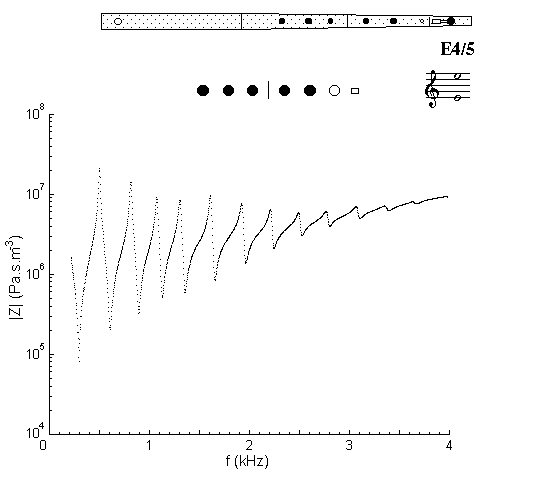| Acoustics of baroque, classical and modern flutes |
baroque flute |
E4 |

|
Acoustic and Fingering Schematic Non-specialist introduction
to acoustic impedance |
From E4 to B4 and E5 to B5, the simple fingerings (i.e. those that do not involve cross-fingering) serve for two notes. The flutist uses the same fingering for E4 and E5, but changes the speed, length and shape of the jet.
The hole of the RH 3rd finger is placed higher than acoustic arguments would recommend, in order to bring it within easy reach of the finger. Consequently, it must be smaller than expected (at 4.3 mm diameter, the smallest on the instrument).
We could call this an implicit cross-fingering: even though no finger hole is closed below the first open one (RH 3rd), the key is in the closed position. The extent of the standing wave beyond an open hole increases with the frequency, especially for small holes. This has the effect of making the effective length of the flute increase with frequency. As a result, the minima at higher frequencies are flatter than strict harmonic ratios. For more on cross fingerings, download a brief scientific report.
Note that, even with just one hole open, some of the regularity of the response curve for D4 has disappeared. The fifth and some higher minima are shallower and not harmonic. Thus the higher harmonics are weaker than for D4, and so the tone is noticeably darker.

Sound spectrum
of a baroque flute played using fingering for E4.
![]()
![]()
![]()
![]() You can hear E4
played by Matthew Ridley.
You can hear E4
played by Matthew Ridley.
| Acoustic measurements are available for these flutes - modern B, modern C, classical C, classical D, classical flared, baroque Sound clips are available for modern B, classical flared and baroque |
To compare flutes, it is easiest to open a separate browser window for each instrument. |